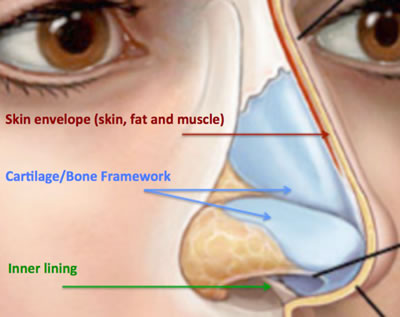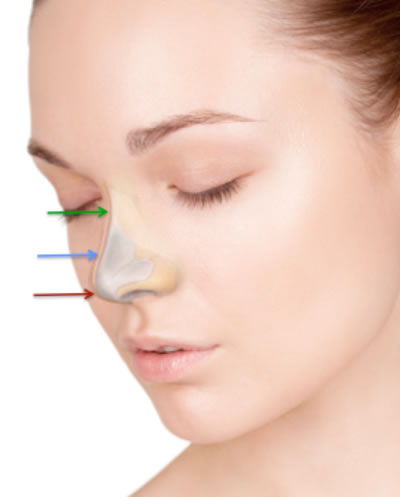THE NOSE
The nose consists of three layers, from the outside in. Using a comparison with a house, we explain the layered structure of the nose. The skin over the nose has different thicknesses. It is thin over the bridge of the nose, but thicker over the lower third of the nose. Some patients have thin skin, others have thick skin. The skin can be thought of as the cladding or paint that covers the house. If the covering is thick, the underlying structures (cartilage and bone) will be less pronounced. With a thin coating, the underlying structures are clearly visible and small irregularities are visible to the eye.

CARTILAGE AND BONE STRUCTURE
Green arrow > bones of the maxilla (zygomatic bone) and nasal bones
Blue arrow > septum attached to the upper lateral cartilage
Red arrow > lower lateral cartilage
The nose is supported by the bone and cartilage structure. The upper part of the nose is supported by the bones of the upper jaw (zygomatic bone and nasal bones).
The middle third of the nose is supported by the septum attached to the upper lateral cartilage. These cartilages support the middle part of the nose. Loss of support leads to a saddle nose, a deformity in which the bridge of the nose has collapsed, or in some cases to a septal perforation (hole in the septum).
The lower third of the nose is supported by the lower third of the lateral cartilage. These cartilages are curved and angle outward to give the characteristic shape to the tip and part of the sides of the nostrils (alar). They help support the tip and nostrils (alar) of the nose.
The septum at the upper lateral cartilage, the lower lateral cartilage and the nasal bones give the shape of the nose (this is also influenced to some extent by the thickness of the skin).

INSIDE
The inner layer of the nose is made up of skin and mucous membrane. It is a vital layer of the nose and can be thought of as the foundation of the house. Any deficiencies (cracks or holes) allow bacteria normally carried in the nose to infect the middle structure of the nose, causing damage to the cartilage of the nose and weakening its supporting structure. In addition, these openings heal by scarring and contraction, causing the nose, which is mobile, to become twisted and the nostrils to become narrowed. This can impede breathing and cause external nasal deformity. This can be compared to a defective foundation in a house that leads to subsidence.
MAKE AN APPOINTMENT?
LEAVE YOUR NUMBER AND WE WILL CALL YOU BACK
